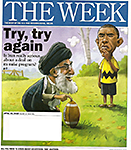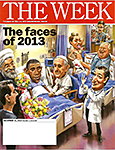A SHORT INSIGHFUL HISTORY OF THE WEEK
SOMETIMES, our Hindsight department serves a sort of “scrapbook” function—as, in fact, the entire Rancid Raves operation does. I see something I particularly like, I post it hereabouts. Even if its connection to comics as tenuous. And that’s purely the case with the article we’re posting below.
This article is part of The Week's special section celebrating the magazine's 20 years in print. It originally appeared in the April 16, 2021 issue. The Week is one of the chief sources of news and commentary in our Editoonery department—and elsewhere—so we thought it would be instructive and useful to know the magazine’s history and attitude. So here it is—:
A SHORT HISTORY OF THE WEEK
By William Falk, Editor in Chief; April 15, 2021
“We launched this magazine into a world very different from today's. This is why we've thrived, and what we've seen.”
The Week was born amid a strange stillness. In April 2001, the furor over the contested 2000 election had subsided, and George W. Bush was just 100 days into what one of our early covers called "The quiet presidency." The nation was at peace, and the partisan rancor of the Clinton impeachment was, for the moment, in remission. It was so placid that summer, in fact, that newspapers and TV news paid inordinate attention to several shark attacks on the East Coast; there were times we struggled to find the meaty, idea-driven debates that are the heart of the magazine. But in this stretch of historical flatwater, the faint sound of rapids could be heard. In our July 6, 2001, issue, the Briefing in our magazine was headlined "Osama bin Laden's war on America."
We all have our 9/11 memories. Mine is rounding a corner on my way to The Week's midtown office on that mild morning of blue skies, minutes after the second plane hit the South Tower. All traffic had stopped on Fifth Avenue; people stood in the street gaping at the obscene gashes in the towers, the tongues of orange flames, the sinister black smoke billowing forth.
"Two planes?" I asked a cop. He nodded and our eyes met. We both knew what that meant. America was under attack. Our brief vacation from history was over.
From that day forward, we have not lacked for news and controversy. The magazine boasts — with a wink — that we curate and distill "all you need to know about everything that matters." Since 9/11 ruptured the world, "everything" has been a deluge. During these two decades, the U.S. has launched two enduring wars, battled ISIS, suffered a catastrophic financial collapse and recession, endured innumerable, heartbreaking mass shootings, elected its first Black president, legalized gay marriage, waged bitter culture war, expanded health-care coverage, saw the internet permeate virtually every aspect of our lives, witnessed the rise of the #MeToo and Black Lives Matter movements, put a New York City real estate tycoon and reality-tv star in the White House, conducted two impeachments, and survived an assault on the Capitol and an attempt to overturn an election. Over the past year, a bat virus from China infected 130 million people, paralyzed the world, and killed nearly 3 million, including more than 550,000 Americans.
What a stretch of history it has been. Horrifying at times, thrilling at others, deeply transformative and consequential. The unique format of The Week has given me, and I hope our readers, an education along the way — a tour through ideas and perspectives from some of the best journalists, thinkers, and critics here and abroad, as they help us try to make sense of it all.
The Week is a magazine of curation: we gather, filter, and distill news and opinion from hundreds of newspapers, websites, and magazines. When we group differing perspectives — liberal, conservative, libertarian, and unclassifiable — in one place, and bang them against one another in a dialectical pursuit of truth, a kind of alchemy occurs. Insights, patterns, new ideas, and even wisdom can emerge. Dots get connected. Where things stand becomes a little clearer. At times, there are glimpses of what comes next.
I wish my staff and I could claim credit for inventing this clever format, but we are instead its fortunate inheritors. The Week began in 1995 in a converted London garage. Co-founders Jolyon Connell, a veteran newspaper journalist, and Jeremy O'Grady, a former British film censor, created a new magazine to solve a problem: most Londoners read only one of the nine national newspapers, each with a distinct political and demographic niche. Wouldn't it be better if the differing worldviews of these publications were herded into one arena and pressed into debate, for the enlightenment and entertainment of busy readers?
This was The Week's founding premise.
This clever new publication emphasized lively, succinct writing rather than wordy, self-important "journalese." Brevity and clarity were its hallmarks, with a heaping helping of wit and deadpan British irony. Amid serious discussion of weighty matters, The Week had a twinkle in its eye, a willingness to be amused by human foibles. That twinkle can be seen in the distinctive illustrated covers of The Week — which derive from a long British tradition of political satire in such magazines as Private Eye and Punch — as well as in features such as "It Must Be True, I Read It in the Tabloids," "Not All Bad," and "Good Week/Bad Week."
 |
 |
[The magazine’s caricatural cover has changed over the last three or four months. Now it’s more illustrative and less caricature. Too bad. But the rest of The Week plunges onward, irresistibly.—RCH]
One of The Week's earliest fans was an eccentric British publisher and entrepreneur named Felix Dennis. So convinced was Felix that the two chaps in the garage had come up with a successful idea that he bought a piece of the magazine from them, and later full ownership, while they continued to write and edit it.
In April 2001, Felix launched a U.S. edition of the magazine to great skepticism. "Is Felix Dennis Mad?" asked The Wall Street Journal on its front page, noting that the market for news and opinion weeklies was already crowded with such venerable titles as Time, Newsweek, and U.S. News & World Report. But Felix was a true entrepreneur — a gambler who trusted his gut.
"I have one talent," he often said, "and that is knowing what people want two minutes before they know it themselves."
I'd like to report The Week was successful in the U.S. two minutes, or even two years, after our first issue. But we were not. To make a long story shorter — which is what we do here at The Week — our readership steadily grew into the hundreds of thousands, and we began turning a profit 15 years ago, to Felix's great satisfaction. He passed away in 2014, knowing he'd been right. We've continued to flourish.
In the early days, internet journalism was still in its infancy, and our office was piled high with newspapers and magazines. Our editors spent hours tearing out or photocopying articles like patches of fabric for the new quilt we made every week. Over time, our research process has migrated mostly to online versions of our source publications. In place of the nine British newspapers that originally formed the basis of The Week, we now draw from hundreds of publications here and abroad; in each issue, we quote from more than 200 sources, after sifting through thousands of articles for the wheat, not the chaff.
Our busy, intelligent subscribers essentially hire our staff to read everything they don't have time to read and to give them a pithy report: here's what happened this week, here's what smart people are saying about it, and here's where it may be going next.
How do we do what we do? I am often asked. Some wonder if we use an algorithm, or spreadsheets, or some other automated tool for processing and crunching thousands of articles. But no: we read. We read for hours every day. The news staff, including managing editors Theunis Bates and Mark Gimein, reads U.S. news and business sources; our deputy editor/international, Susan Caskie, reads and translates publications abroad; our arts staff, headed by deputy editor Chris Mitchell, consumes a wide swath of cultural coverage and reviews.
As we read, we compile lists of stories, grouping those on the same topic together, and begin to discern the shape of the next issue. What are people talking about, arguing over, wondering? What books, films, music, theater, and consumer products deserve your time, attention, and money? These questions constitute our algorithm.
The hardest part is the writing. Brevity requires compression, and compression requires struggle and sweat. "I apologize for such a long letter," Mark Twain once said. "I didn't have the time to write a short one."
Before writing short ones, our writer-editors read through a pile of news stories and opinion columns that can number in the dozens, and then, in a few hours, rewrite them into a 500- or 700-word article that is sprightly, clear, and densely packed. In our opinion-based pieces, such as Main Stories, Controversy of the Week, Talking Points, and the reviews on our arts pages, The Week's writer-editors weave arguments from several sources into a coherent essay — a roundtable discussion of a single topic with multiple points of view.
If I may be immodest, it's an art to do it well. Our articles take readers on a tour of ideas, information, and perspectives, giving them the raw materials with which to form their own opinion. For those who already hold strong opinions, our articles can illuminate how the other side thinks and why.
This exercise in open-mindedness often leads to seeing the world as more gray than black and white. Truth is always elusive, but in my experience, it generally can be located somewhere between the extremes.
The Week is a nonpartisan magazine, and we view all politicians and political parties with appropriate skepticism. I often say that The Week has one bias, and that is for evidence.
We operate under the assumptions that intellectual honesty and consistency matter and that ideas should be openly discussed, not suppressed. In giving readers a menu of conflicting ways to see a given issue, we believe that mere assertion carries little weight. If you contend, for example, that the sky is green, you need to back it up with some persuasive, factual evidence. Show us why we should believe the sky is green. "Because I say so" or "this is what my tribe thinks" isn't a serious argument.
Sorting good-faith argument from nonsense has, I must admit, become more challenging in recent years. Conspiracy theories and disinformation have gone mainstream, and social media and partisan news outlets cynically churn out blatant falsehoods like counterfeit bills. Over the past 20 years, the partisan divide has widened and grown more bitter and tribal. Our politics is in the grip of "negative partisanship" — knee-jerk, irrational opposition to the "other side" and everything those awful people say, want, or think.
As a cautious optimist, I would like to think we've already hit rock bottom on that descent into mindless polarization. I see signs we have started on the way back up to more civil, intellectually honest, and open-minded debate. The Week is where you'll find it — succinct, lively, and with a twinkle in our eye. I hope you'll continue on the journey with us.
This article was first published in The Week magazine. If you want to read more like it, you can visit the magazine’s website, theweek.com

